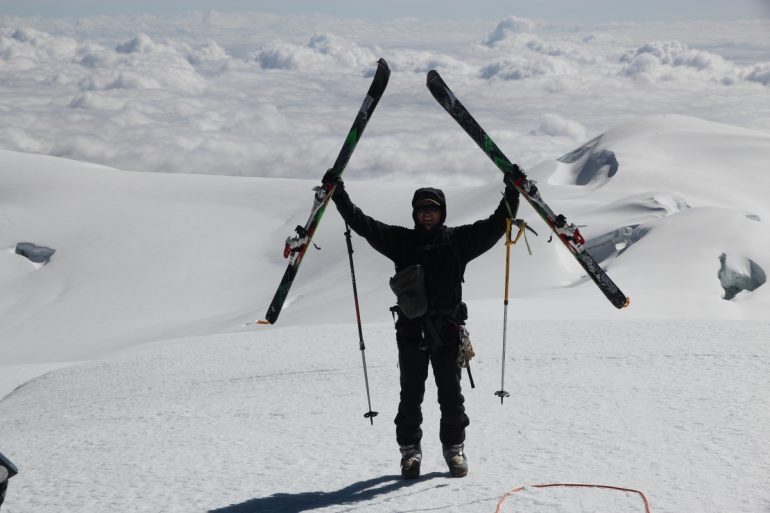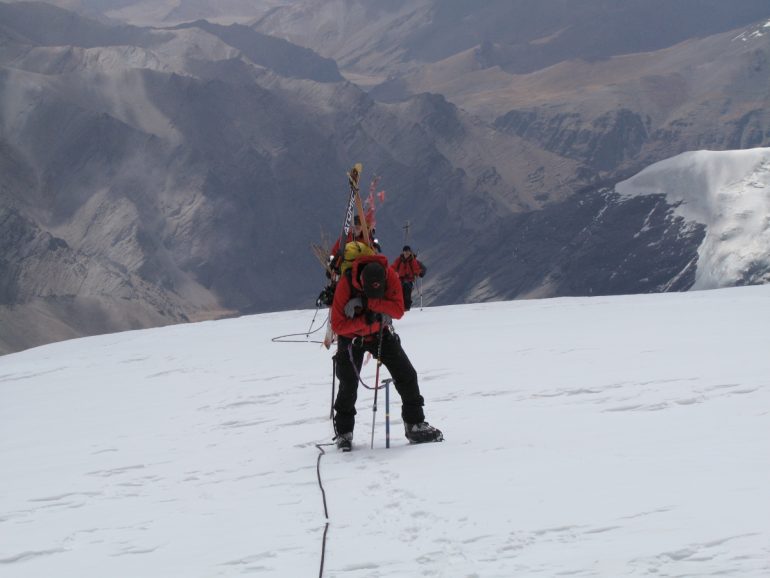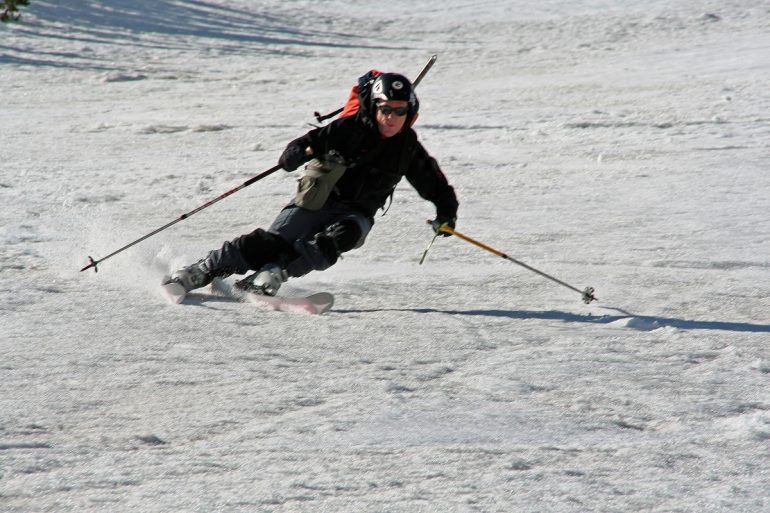
There is no better feeling than reaching the top with “gas in the tank” to ski back down. Photo: Steve Marolt
How resistance training can strengthen downhill skiing
It’s that time of year when people are looking ahead towards ski season, and often I get emails and messages asking me: “what are you doing to get in shape for the ski season?” The reality is, the best way to get in shape for skiing is actually skiing. So regardless of what you do before you click into your bindings, remember when the snow flies, you need to break into the season slowly. In the meantime, however, there are things you can do that will greatly increase and expedite your ability to regain that mid-season form. The main ingredient? Resistance training.
For AT skiing and ski mountaineering, there is an obvious need to push for endurance. You have to be able to climb up to get to the skiing. The good news is that most uphill athletes effectively convert from season to season whether skiing to biking or trail running, hiking etc. Especially in mountain communities, endurance training is more a way of life than training. It’s part of our culture. I shudder to refer to it as training at all. So I won’t bore you with that. What I do want to discuss is the actual “training” needed to round out an uphill athlete’s winter ambition — to ski down after an enduring climb.
Some physiology of skiing
At age 54, after some 30 years of climbing for my own skiing, the ramifications of my pursuits are often painfully obvious. Not to get too technical, but when a skier inclines at a mere 30%, an average moderate speed turn, the combination of gravity and body weight creates up to 1.5 G’s, or rather his or her weight plus half of it again. The faster you go and the higher you jump, the more pressure you create. There’s nothing you can do to eliminate this pressure, but the sensation of it all is what many psychologists suggest makes skiing desirable in the first place. But with the addictive sensation of skiing comes wear and tear on your body. Bluntly put, the human body has not evolved to be a skier.
The body does however have mechanisms in place to accommodate it; our muscles, tendons, cartilage, and bones work together to “even the load,” if you will. But the issue for AT skiing is that after a significant effort to reach the top of a slope you want to ski, often the critical component of the system, your muscles, become extremely fatigued, leaving the tendons, cartilage, and bones to take up the load. It gets worse. With prolonged endurance training alone, the mass of all components is lost. This is why endurance runners are so thin, and why after the Tour De France athletes have to watch their steps, literally, with broken bones being a common injury due to excessive bone density loss. But even by the day, for ski mountaineering, what seems like an “easier way” to descend, on skis compared to walking, actually becomes a monumental task after hours of climbing. Tired muscles subject you to sloppy unsatisfying skiing at best, and injury at worst to bones and tendons that rely on muscles to take the brunt of the load. So the idea is not to eliminate endurance, but to enhance it. The key is resistance training.
How resistance training fits in
Disclaimer: I’m not a physical therapist or professional trainer so I won’t pretend I have the answers or suggest a regimented routine. What I do have is a few decades of ski mountaineering that included seemingly endless training with also seemingly endless experimenting. Coupled with many hundreds if not thousands of days climbing and skiing, the overall gist of what I have discovered is that “training” can be and should become part of the AT skiing lifestyle. I honestly believe that what success I’ve achieved in the backcountry can be attributed to forcing myself — gasp — to including regular and consistent trips to the weight room.
The downside perceived by many endurance athletes is that adding resistance training detracts from the ability to say run up Aspen Mountain in less than 40 minutes. And that is a fair assessment. Resistance training builds muscle which adds weight to your body which slows down an endurance athlete. For AT skiing and especially ski mountaineering, however, we are dealing with a sport that includes both a need for power and endurance. As I said before, skiing requires the human body to deal with forces that are simply not normal.
For me, and again, I am not professing to be an expert, what I have found is that while I never forgo resistance training in my weekly routine, for the few months before ski season, I definitely concentrate my gym workouts to be slightly more intensive towards overall power and strength training. During the summer I generally ride my mountain bike for two days, trail run for two days, and hit the gym two days with one day to rest. During the fall when the weather gets mucky, I put the bike away and add another day in the gym eliminating a bit of endurance training. By around turkey day, I am a few pounds heavier than during the summer, my endurance is not what it was in July, but my power and endurance are in key shape to take on skiing. Then, when the snow flies and I can click into my skis, I am ready to ski into shape.
This is fairly generic, but with purpose. People come in all shapes and forms, and also have different goals for their skiing. So you have to figure out what is best for you. Talk to trainers. Read books. Talk to other people with similar desires. Age is also a critical factor. At my age, I can no longer squat under a barbell with enormous weight or much weight at all. My body simply can’t take the torque of heavy weight lifting. But I can do a variety of TRX and rubber band work as well as body weight repetitions (e.g. one leg squats and jumps etc.) and have found great success.
There is also a plethora of classes professional trainers offer as “Ski Conditioning.” I’m not much for classes, but many people rave about the success of these. The key is to make training enjoyable so you want to do it. It’s tough to sacrifice a beautiful fall afternoon to go inside to a gym, I get it, but if you can bite the bullet, the sacrifice becomes addictive. I look forward to my gym workouts. And there is no rule you can’t do both. Go for a half hour run and end in the gym. Along those lines, before you hit the resistance training, it is always advisable to warm up for 20 or 30 minutes with aerobic training. That warm up is key. Not only does it prevent potential injury from cold resistance workouts, but with a solid warm up, it allows for a short and super intense resistance training session or less time inside.

The fatigue from a long, high climb can completely deplete you without resistance training. Photo: Steve Marolt
Another thing I have experimented with the past several years is a dreaded sprint routine. One day a week, before I do a resistance routine, I do this 20 minute routine: 6 minutes easy warm up on a tread mill, then a minute sprint followed by a minute to recover, and then repeat 7 times with a warm down. If you just can’t bring yourself to resistance training, a sprint workout is almost as effective. The sprint aspect is a form of resistance training, but physiologically, it also increases your body’s production of growth hormones, which adds power to your entire body. Especially as I have aged, this workout one day per week has become critical for overall power and endurance. It’s not fun, but the results are pretty amazing.
You can make it as regimented or relaxed as you want, but the key is to do it — resistance training for a minimum of three days per week in the months before you ski. The good news: skiing after a long climb with a solid resistance program makes all the difference in the world. Personally, the last few years I’ve tended to forget about the resistance training compared to the high of being able to travel up a mountain as if floating. But I paid the price with abysmal skiing on the descent. Tired legs made the love of skiing almost agony at times. I chalked it up to age. But recently, I added more intensive resistance training back to my routine with methods more appropriate for my age. It has made a tremendous difference allowing me to enjoy why so many people earn their turns — to ski.
Editor’s note: There are as many recipes for developing downhill fitness as flavors in a grocery cereal aisle. For another take on this topic, check out this strength training article from Training the Uphill Athlete.
Mike Marolt is a USA National Ski and Snowboard Hall of Famer. He has spent the last 30 years climbing and skiing with his identical twin brother Steve and lifelong friend Jim Gile on expeditions to over 50 peaks in the 5000 meter to 8000 meter arena. He has produced several films on his expeditions and will release a book on skiing the high peaks this fall. Check out the recent Totally Deep Podcast featuring Mike and Steve.

